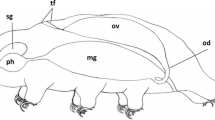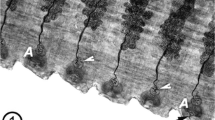Summary
Electron microscope studies were made on the test cells which comprise a part of the follicular envelope in the ovary of the tunicate Ciona. During development the cells become filled with secretory granules. The Golgi complex is well developed and usually centrally located in the cells. The morphological variations shown and described strongly suggest that the Golgi complex is mainly concerned with the origin of the secretion in these cells.
Similar content being viewed by others
References
Beams, H. W., and R. G. Kessel: Electron microscope studies on developing crayfish oocytes with special reference to the origin of yolk. J. Cell Biol. 18, 621–649 (1963).
Bern, H.A., R. S. Nishioka, and I. R. Hagadorn: Association of elementary neurosecretory granules with the Golgi complex. J. Ultrastruct. Res. 5, 311–320 (1961).
—: Neurosecretory granules and the organelles of neurosecretory cells. Mem. Soc. Endocrinology, No 12. Neurosecretion (H. Heller and R. B. Clark, Eds.), p. 21–34. New York: Academic Press 1962.
Berrill, N. J.: The Tunicata. London: B. Quaritch, Ltd. 1950.
Birbeck, M. S. C., E. H. Mercer, and N. A. Barnicott: The structure and formation of pigment granules in human hair. Exp. Cell Res. 10, 505–514 (1956).
Bowen, R. H.: On a possible relation between the Golgi apparatus and secretory products. Amer. J. Anat. 33, 197–218 (1924).
—: The cytology of glandular secretion. Quart. Rev. Biol. 4, 299–324, 484–519 (1929).
Burgos, M. H., and D. W. Fawcett: Studies on the fine structure of the mammalian testis. I. Differentiation of the spermatids in the cat (Felis domestica). J. biophys. biochem. Cytol. 1, 287–300 (1955).
Caro, L. G., and G. E. Palade: Protein synthesis, storage, and discharge in the pancreatic exocrine cell. An autoradiographic study. J. Cell Biol. 20, 473–496 (1964).
Challace, C. E., and D. Lacy: Fine structure of exocrine cells of the pancreas. Nature (Lond.) 174, 1150 (1954).
Dalton, A. J.: A study of the Golgi substance and ergastoplasm in a series of mammalian cell types. In: Fine structure of cells, p. 274–293. New York: Interscience Publ. 1954.
—: Organization in benign and malignant cells. Lab. Invest. 8, 510 (1959).
—: Golgi apparatus and secretion granules. In: The cell, vol. II (J. Brachet and A. E. Mirsky, Eds.), p. 603–620. New York: Academic Press 1961.
Farquhar, M. G., and J. F. Rinehart: Electron microscopic studies of the anterior pituitary gland of castrate rats. Endocrinology 54, 516–541 (1954).
—, and S. R. Wellings: Electron microscopic evidence suggesting secretory granule formation within the Golgi apparatus. J. biophys. biochem. Cytol. 3, 319–322 (1957).
Fawcett, D. W.: Changes in the fine structure of the cytoplasmic organelles during differentiation. In: Developing cytology (D. Rudnick, Ed.), p. 161–189. New York: Ronald Press Co. 1959.
Ferreira, D.: L'ultrastructure des cellules du pancreas endocrine chez l'embryon et le rat nouveau-né. J. Ultrastruct. Res. 1, 14–25 (1957).
Hagadorn, I. R., H. A. Bern, and R. S. Nishioka: The structure of the supraesophageal ganglion of the rhynchobdellid, Theromyzon rude, with special reference to neurosecretion. Z. Zellforsch. 58, 714–728 (1963).
Haguenau, F., et W. Bernhard: L'appareil de Golgi dans les cellules normales et cancereuses des vertébrés. Arch. Anat. micr. Morph. exp. 44, 27–55 (1955).
Harvey, L. A.: The history of the cytoplasmic inclusions of the egg of Ciona intestinalis (L.) during oogenesis and fertilization. Proc. roy. Soc. B 101, 136–162 (1927).
Hendler, R. W., A. J. Dalton, and G. G. Glenner: A cytological study of the albumin-secreting cells of the hen oviduct. J. biophys. biochem. Cytol. 3, 325–330 (1957).
Herman, L., and P. J. Fitzgerald: The fine structure of the Golgi body following thyroid stimulation and pancreatic regeneration. Trans. N. Y. Acad. Sci. 23, 332 (1961).
Heyningen, H. van: Secretion of protein by the exocrine pancreas of the rat as studies by electron microscopic radioautography. Anat. Rec. 148, 322 (1964).
Kessel R. G., and H. W.Beams: An unusual configuration of the Golgi complex in pigment producing “test” cells of the ovary of the tunicate, Styela. J. Cell Biol. (1965) (in press).
—, and N. E. Kemp: An electron microscopic study on the oocytes, test cells and follicular envelope of the tunicate, Molgula manhattensis. J. Ultrastruct. Res. 6, 57–75 (1962).
Knaben, R.: (Cit. from Tucker 1942.) Bergens Mus. Aarb. 1, 1 (1936).
Luft, J. H.: Improvements in epoxy resin embedding methods. J. biophys. biochem. Cytol. 9, 409–414 (1961).
Mollenhauer, H. H., and W. G. Whaley: An observation on the functioning of the Golgi apparatus. J. Cell Biol. 17, 222–235 (1963).
Novikoff, A., and S. Goldfischer: Nucleosidediphosphatase activity in the Golgi apparatus and its usefulness for cytological studies. Proc. nat. Acad. Sci. (Wash.) 47, 802–810 (1961).
Novikoff, A. B., E. Essner, S. Goldfischer, and M. Heus: Nucleosidephosphatase activities of cytomembranes. Symp. Int. Soc. Cell Biol. (The interpretation of ultrastructure, R. J. C. Harris, Ed., New York, Academic Press) 1, 149–192 (1962).
Palade, G. E.: A study of fixation for electron microscopy. J. exp. Med. 95, 285–298 (1952).
—: Intracisternal granules in the exocrine cells of the pancreas. J. biophys. biochem. Cytol. 2, 417–422 (1956).
Palay, S. L.: Morphology of secretion. In: Frontiers in cytology (S. L. Palay, Ed.), p. 305 to 342. New Haven: Yale University Press 1958.
—, and L. J. Karlin: Absorption of fat by jejunal epithelium in the rat. Anat. Rec. 124, 343 (1956).
Peterson, M. R., and C. P. Leblond: Synthesis of complex carbohydrates in the Golgi zone as revealed by radioautography. Anat. Rec. 148, 322 (1964).
Rinehart, J. F., and M. G. Farquhar: Electron microscope studies of the anterior pituitary gland. J. Histochem. Cytochem. 1, 93–113 (1953).
Scharrer, B.: Neurosecretion. XIII. The ultrastructure of the corpus cardiacum of the insect, Leucophaea maderae. Z. Zellforsch. 60, 761–796 (1963).
Scharrer, E., and S. Brown: Neurosecretion. XII. The formation of neurosecretory granules in the earthworm, Lumbricus terrestris L. Z. Zellforsch. 54, 530–540 (1961).
Siekevitz, P., and G. E. Palade: Cytochemical study on the pancreas of the guinea pig. I. Isolation and enzymatic activities of cell fractions. J. biophys. biochem. Cytol. 4, 203–218 (1958a).
—: Cytochemical study on the pancreas of the guinea pig. II. Functional variation in enzymatic activity. J. biophys. biochem. Cytol. 4, 309–318 (1958b).
—: Cytochemical studies on the pancreas of the guinea pig. VI. Release of enzymes and ribonucleic acid from ribonucleoprotein particles. J. biophys. biochem. Cytol. 7, 631–644 (1960).
Sjöstrand, F. S., and V. Hanzon: Ultrastructure of Golgi apparatus of exocrine cells of mouse pancreas. Exp. Cell Res. 7, 415–429 (1954).
Slautterback, D. B., and D. W. Fawcett: The development of the cnidoblasts of Hydra, an electron microscope study of cell differentiation. J. biophys. biochem. Cytol. 5, 441–452 (1959).
Tucker, G. H.: The histology of the gonads and development of the egg membranes of an ascidian (Styela plicata, Lesueur). J. Morph. 70, 81–114 (1942).
Watson, M. L.: Staining of tissue sections for electron microscopy with heavy metals. J. biophys. biochem. Cytol. 4, 475–478 (1958).
Weiss, J. M.: The ergastoplasm. Its fine structure and relation to protein synthesis as studied with the electron microscope in the pancreas of the Swiss albino mouse. J. exp. Med. 98, 607–618 (1953).
Wellings, S. R., and B. U. Siegel: Role of the Golgi apparatus in the formation of melanin granules in human malignant melanoma. J. Ultrastruct. Res. 3, 147–154 (1959).
Author information
Authors and Affiliations
Additional information
Supported by research grants (GM-9229, 9230) from the National Institute of General Medical Science, United States Public Health Service.
This investigation was supported by a Public Health Service Research Career Program Award (1-K3-GM-11, 524) from the National Institute of General Medical Sciences.
Rights and permissions
About this article
Cite this article
Kessel, R.G. The role of the Golgi complex in the formation of secretion in the test cells of the follicle of the tunicate, Ciona . Zeitschrift für Zellforschung 66, 106–117 (1965). https://doi.org/10.1007/BF00339320
Received:
Issue Date:
DOI: https://doi.org/10.1007/BF00339320




